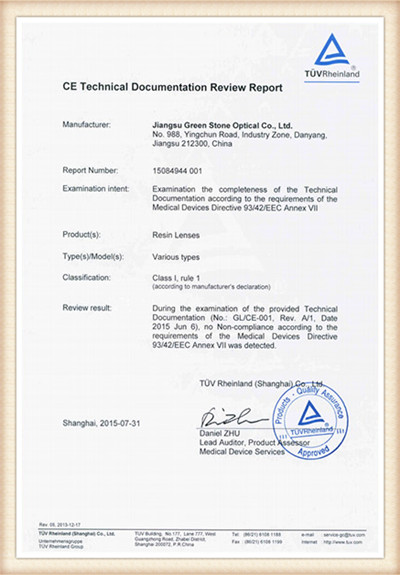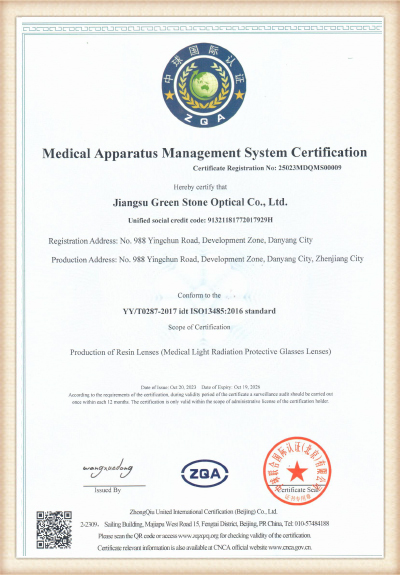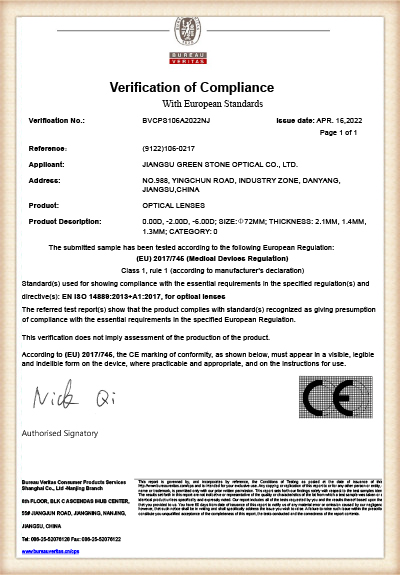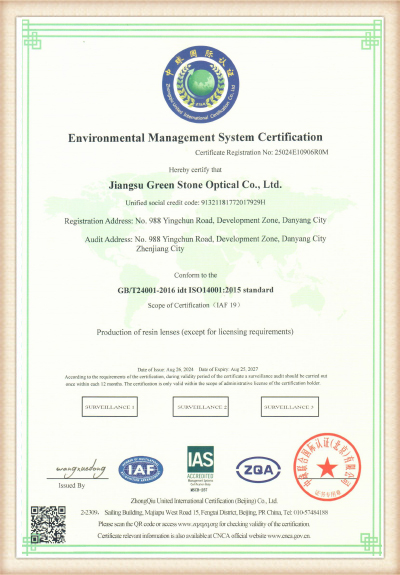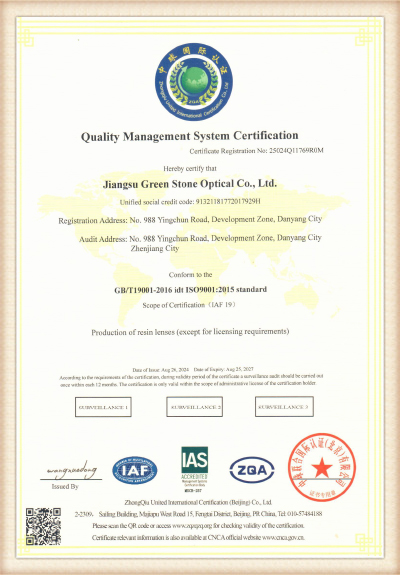Introduction to Core Concepts: The Purpose of Polarized and Photochromic Lenses Advanced lens technologies are designed to enhance visual comfort and protect the eyes from harmful light. Among the many high-quality options, Polarized Lenses and Photochromic Lenses are two of the most popular choices, yet they address d...
READ MORE
Product Series
Regular Rx Lens Manufacturers
-


RX 1.499 1.56 1.60 1.67 1.74 Single Vision Progressive Blue Block Round Top Flat Top Bifocal Photochromic Lens
Lens surfaced according to prescriptions in the lens laboratory is cal...
Regular RX Lens is a high-performance optical lens designed to meet diverse vision correction needs. It uses advanced materials and precision manufacturing processes to ensure visual clarity and highly accurate degree matching. Its core advantage lies in its excellent scratch resistance, anti-reflection and anti-fouling properties, which greatly improves the durability and service life of the lens and greatly reduces the visual interference caused by scratches and stains during daily wear.
Regular RX Lens supports full customization and can be accurately produced according to the degree and pupil distance requirements of different users. It is widely used in a variety of vision correction solutions such as myopia, hyperopia and astigmatism. The lens design focuses on lightness and beauty, ensuring that the wearer can experience a relaxed and comfortable wearing experience while obtaining clear vision, suitable for long-term use.
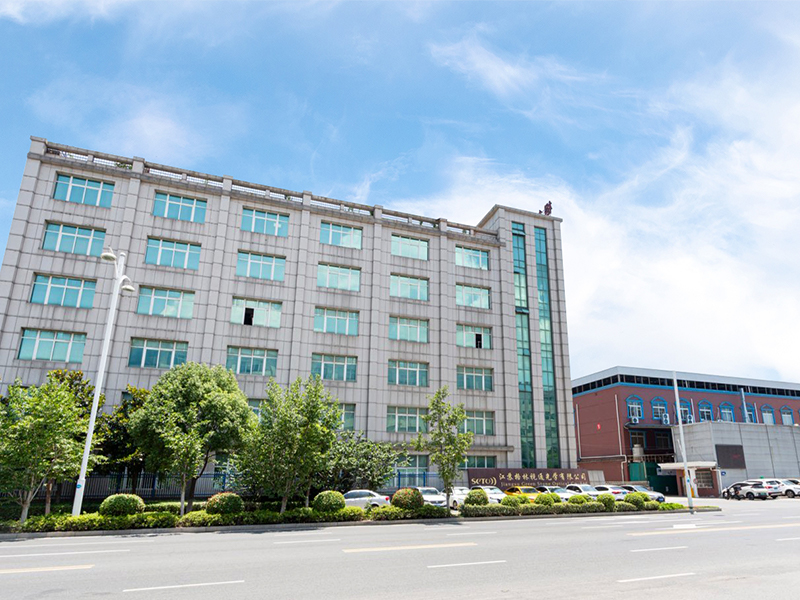
Our lens products involves almost all types of lenses. Product range covers 1.499, 1.56, 1.60, 1.67, 1.70 and 1.74 index, including single vision,bifocal, progressive, blue cut, Photochromic, blue cut photochromic, Infrared cut etc. with HC, HMC and SHMC treatment. Besides finished lens, We also manufactures semi-finished blanks. The products are registered with CE&FDA and our production certified by ISO9001& ISO14001 standards.
We positively introduce excellent management technology, comprehensively import Corporate Identity System and enhance the external image of company and brand.
-
-
Introducing Normal Lenses and Defocus Lenses In the fields of optics and image capture, the lens is a core component responsible for guiding and shaping light to form an image on a sensor or retina. While all lenses are based on the same laws of physics, their design goals and final effects can vary widely. This articl...
READ MORE -
Unveiling the Technology of Bifocal Lenses Introduction to Bifocal Lenses A bifocal lens is a powerful and time-tested solution in vision correction. Simply put, it is a corrective lens that contains two distinct optical powers within a single lens surface. This design addresses a common challenge faced by millions: ne...
READ MORE
What Are the Optical Performance Indicators of Regular Rx Lens?
In the modern eyewear industry, Regular Rx Lens — as one of the most widely used optical lens types — plays a crucial role in determining visual clarity, comfort, and overall product quality. As a professional optical lens manufacturer integrating R&D, production, and sales, Jiangsu Green Stone Optical Co., Ltd. is dedicated to continuous breakthroughs in optical precision and technological innovation. With a 65,000-square-meter production base, over 350 employees, and advanced equipment, our Regular Rx Lens products serve both domestic and global markets, certified by CE, FDA, ISO9001, and ISO14001 standards.
1. Refractive Index
The refractive index is one of the core indicators of optical performance, determining the lens’s ability to bend light and its resulting thickness. Jiangsu Green Stone Optical Co., Ltd. offers a full range of indices from 1.499, 1.56, 1.60, 1.67, 1.70 to 1.74, allowing flexible selection based on prescription, frame design, and user needs. 1.499 lenses: stable optical performance, ideal for low prescriptions and cost-effective applications. 1.60 and 1.67 lenses: balance thinness and high refractive power — the current global mainstream choice. 1.74 ultra-high index lenses: provide an extremely lightweight experience for high myopia users. By precisely controlling refractive index parameters, Green Stone ensures realistic imaging, minimized edge distortion, and enhanced wearing comfort.
2. Abbe Value
The Abbe value measures a lens’s control over chromatic aberration — the higher the value, the less color dispersion occurs. Our Regular Rx Lenses use high-Abbe-value resins such as CR-39 and MR series materials, maintaining pure imaging even under various lighting conditions. By balancing refractive index and Abbe value, Green Stone lenses achieve both thinness and high color fidelity, avoiding color fringes and blur under strong or dim lighting.
3. Transmittance and Protection
Transmittance determines image brightness and clarity. Jiangsu Green Stone Optical Co., Ltd. adopts advanced vacuum coating technology to maintain visible light transmittance up to 98% while filtering harmful rays. UV400 protection completely blocks ultraviolet rays, protecting the retina and ocular health. Blue Cut technology reduces blue light damage from digital devices. Infrared Cut coating effectively lowers heat radiation and improves visual comfort. Additionally, our Photochromic and Blue Cut Photochromic series automatically adjust transmittance under varying light conditions, ideal for multi-environment use.
4. Coating Technology
The coating process directly impacts a lens’s scratch resistance, cleanliness, and anti-reflection capability. Green Stone Optical utilizes a triple-layer coating system: HC (Hard Coating) enhances scratch resistance and lens durability; HMC (Hard Multi-Coating) reduces glare and improves light transmission; SHMC (Super Hydrophobic Multi-Coating) repels water, dust, and oil for long-term clarity. With advanced ion coating equipment and cleanroom production, Green Stone ensures dense, uniform coatings that meet international optical standards.
5. Optical Axis and Prescription Accuracy
Optical center alignment directly influences wearer comfort. Green Stone employs automated digital inspection systems to monitor sphere (SPH), cylinder (CYL), and axis (AXIS) parameters throughout production, ensuring optical center deviation remains within ±0.05mm. This precision ensures each Regular Rx Lens perfectly matches the prescription, minimizing visual strain and distortion — especially beneficial for long-term wearers.
6. Material Stability and Environmental Adaptability
Jiangsu Green Stone Optical Co., Ltd. enforces strict ISO-based quality control across raw material sourcing, resin formulation, molding, and annealing. Our Regular Rx Lenses exhibit excellent heat resistance and impact strength, maintaining optical stability even under high temperature, humidity, or intense sunlight. This reliability provides assurance for B2B clients distributing to diverse climates such as Southeast Asia, Europe, and South America.
How Do Different Materials Affect the Performance of Regular Rx Lens?
In optical lens manufacturing, material selection is a decisive factor affecting lens performance. The optical clarity, weight, durability, and comfort of Regular Rx Lens depend heavily on the resin material used. As a professional optical lens manufacturer, Jiangsu Green Stone Optical Co., Ltd. utilizes its 65,000-square-meter facility and advanced global technologies to precisely control resin formulations and molding processes, ensuring superior-quality Regular Rx Lenses across all refractive indices.
1. CR-39 Material: The Classic Optical Resin
CR-39, with a refractive index of 1.499, is known for excellent transparency and a high Abbe value (~58). It provides very low chromatic dispersion and a natural, true visual experience. Jiangsu Green Stone Optical Co., Ltd. enhances its CR-39 Regular Rx Lenses through improved HC, HMC, and SHMC coatings, greatly increasing scratch resistance and durability. These lenses are ideal for low prescriptions and users seeking high clarity and visual comfort.
2. 1.56 Mid-Index Material: Balance of Thinness and Cost
With the trend toward lightweight eyewear, 1.56-index material has become a mainstream choice. It strikes an ideal balance between thickness reduction, optical performance, and affordability. Jiangsu Green Stone Optical Co., Ltd. applies proprietary mid-index resin systems that maintain high Abbe values and superior impact resistance. Using precision molds and automated injection molding, Green Stone produces Regular Rx Lenses with excellent curvature uniformity and optical center accuracy — widely used in daily prescription, blue-cut, and progressive lenses.
3. 1.60 High-Index Material: Aesthetic and Performance Harmony
For medium to high prescriptions, lens thickness directly impacts aesthetics and comfort. 1.60 high-index materials reduce thickness by 20–25% while maintaining optical quality. Jiangsu Green Stone Optical Co., Ltd. uses Japan’s imported MR-8 resin featuring high transparency, toughness, and stability. Combined with advanced SHMC coatings, our 1.60 Regular Rx Lenses deliver outstanding clarity and anti-reflection performance — perfect for users seeking lightweight, high-definition eyewear.
4. 1.67 & 1.70 High-Index Materials: Advanced Thin-Lens Technology
With technological progress, 1.67 and 1.70 index resins represent the evolution of high-end prescription lenses. They provide improved durability, imaging precision, and edge distortion control. Jiangsu Green Stone Optical Co., Ltd. tightly regulates molding temperature, curing speed, and annealing to ensure molecular stability and eliminate internal stress. These lenses are ideal for high myopia users and premium eyewear applications requiring ultra-thin aesthetics.
5. 1.74 Ultra-High Index Material: The Pinnacle of Thinness
1.74-index resin represents the cutting edge of optical technology, achieving extreme thinness while maintaining optical purity and high heat resistance. Jiangsu Green Stone Optical Co., Ltd. uses imported high-molecular polymers and proprietary stress-release processing, ensuring high strength and stability despite a 40% reduction in thickness. This series is ideal for high prescriptions and high-end OEM/ODM projects emphasizing both elegance and optical excellence.
6. Functional Materials: Fusion of Protection and Comfort
Beyond standard resins, Jiangsu Green Stone Optical Co., Ltd. also develops functional optical materials: Blue Cut materials block harmful short-wave blue light and reduce digital eye strain. Photochromic materials use photo-reactive molecules for automatic light adjustment. Infrared Cut resins reduce thermal radiation, protecting the cornea and lens from heat damage. These innovations turn Regular Rx Lens into a technology-driven optical protection solution rather than just a vision correction tool.
How to Ensure Optical Axis Consistency and Prescription Accuracy in Regular Rx Lens Production?
In optical manufacturing, Optical Axis Consistency and Prescription Accuracy are two core metrics that define lens quality and visual comfort. For Regular Rx Lens, even minimal misalignment or prescription error can cause fatigue, ghosting, or dizziness. As a professional optical lens manufacturer, Jiangsu Green Stone Optical Co., Ltd. regards optical precision as its key competency, implementing advanced production systems, precise inspection, and strict quality control to ensure every Regular Rx Lens meets international standards.
1. Importance of Optical Axis Consistency
The optical axis is the reference line of the optical system that determines how light passes and focuses through the lens. In prescription lenses, the optical axis must align perfectly with the wearer’s visual center; otherwise, it may lead to eye strain or distorted vision. Jiangsu Green Stone Optical Co., Ltd. utilizes fully automated optical-center positioning systems during molding, cutting, and polishing to maintain precise alignment. With proprietary optical-center modeling, Green Stone controls axis deviation within ±0.05mm — significantly surpassing industry averages.
2. Principles of Prescription Accuracy
Prescription accuracy includes sphere (SPH), cylinder (CYL), axis (AXIS), and pupillary distance (PD). Jiangsu Green Stone Optical Co., Ltd. applies precision mold design and digital machining to achieve a closed-loop prescription control process: Sphere/Cylinder precision: freeform generators ensure curvature error ≤0.02D. Axis control: optical simulation systems provide real-time angle correction. Pupillary distance alignment: auto-centration systems ensure perfect overlap between geometric and visual centers. This multi-layer control guarantees precise prescription matching and stable vision in practical use.
3. From Semi-Finished Blank to Finished Lens: Precision at Every Stage
Jiangsu Green Stone Optical Co., Ltd. manufactures both finished lenses and high-quality semi-finished blanks. During blank production, high-purity resin and vacuum injection molding ensure uniform density and minimal internal stress. The annealing process further stabilizes molecular structure and axis alignment. In the grinding and polishing stage, Green Stone employs double-sided automatic polishers with nano-level abrasive compounds, achieving a surface roughness of Ra≤0.02μm for perfect light transmission. This meticulous approach ensures exceptional uniformity and imaging accuracy across all Regular Rx Lenses.
4. Optical Inspection and Automated Quality Control
To maintain prescription precision and axis alignment, Jiangsu Green Stone Optical Co., Ltd. integrates multi-level inspection systems using advanced instruments such as Lens Power Testers, Laser Interferometers, and Wavefront Analyzers to evaluate refraction, axis, and optical distortion. Each batch of Regular Rx Lenses undergoes three inspection stages: In-line self-check — real-time automated correction. Laboratory sampling — verification of refractive accuracy and optical-axis stability. Final inspection — compliance with ISO8980 and EN ISO 21987 standards. This rigorous QC process ensures a 99.8% pass rate, with Green Stone lenses distributed worldwide across Europe, the Americas, and Southeast Asia.
5. Technological Innovation and Continuous Improvement
Certified under ISO9001 and ISO14001, Jiangsu Green Stone Optical Co., Ltd. continuously adopts intelligent manufacturing and data-driven management. The company’s MES (Manufacturing Execution System) tracks all optical parameters in real time, enabling complete production traceability. In mold engineering, Green Stone applies nano-level EDM micro-sculpting, maintaining mold curvature accuracy within ±0.001mm — providing precise templates for subsequent processing. Through ongoing innovation and refinement, Green Stone maintains an industry-leading position in optical-axis control and prescription accuracy management.



 English
English Español
Español
